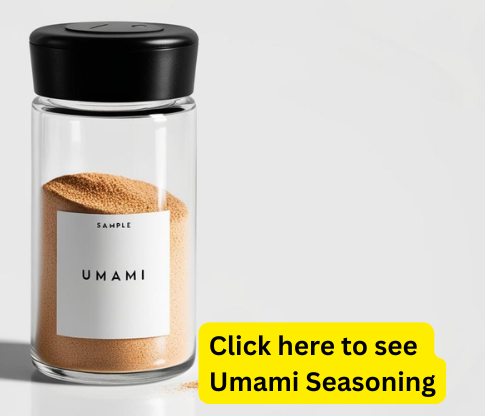So, what’s umami exactly?
Glad you asked.
That’s where this guide comes in.
What is umami?
Umami is recognized as the fifth basic taste, alongside sweet, sour, salty, and bitter.
It can be difficult to define, but umami generally describes a savory, rich, and deeply satisfying flavor.
In Japanese cuisine, umami is considered essential and appears in a wide variety of dishes.
For those unfamiliar with umami, it’s the kind of deep, savory flavor found in a long-simmered stew or well-aged cheese. It is an intense, deeply savory taste.
Umami is a savory “fifth taste” found in foods like soy sauce, mushrooms, and aged cheese.
What does umami mean?
The word umami is written in kanji as 旨味.
These two characters literally mean… “delicious taste”.
Even the word for delicious in Japanese can be umai, showing how essential umami is for a dish to taste good for Japanese people and their culinary tradition.
Note… you can also find Umami related products on Amazon (seasoning and broth)
|
How did umami come about?
In 1908, Japanese chemist Kikunae Ikeda identified glutamic acid as the compound responsible for umami flavor.
This eventually led to the patent of monosodium glutamate or MSG, which is now used in cooking along a wide range of cuisines to enhance flavor.
Umami Rich Foods & Examples
Many foods can be rich in umami due to high levels of glutamates and other umami-enhancing compounds.
For example…
Tomatoes: Tomatoes contain lots of umami. In particular, sun-dried tomatoes and cooked tomatoes inside sauces enhance this flavor even further.
Cheese: Well-aged cheese like parmesan and gouda is rich in umami because of the way the protein breaks down into amino acids during the aging process. Parmesan in particular is considered one of the most umami-rich foods, and it makes sense that it is such a popular cheese to sprinkle on all kinds of dishes to enhance its flavor.
Soy Sauce: A key component of Japanese cuisine, soy sauce contains glutamates due to its long fermentation process when it is brewed.
Mushrooms: Mushrooms are high in glutamates, which makes them an umami-rich food. In particular, dried mushrooms tend to have an even more intense flavor. Dried shiitake mushrooms are often used as a key component in Japanese broths.
- Learn more: Types of Japanese mushrooms
Fish: Dried fish is another staple ingredient in Japanese kitchens. Dried anchovies and bonito flakes create a rich and savory flavor.
Seaweed: Seaweeds also contain high levels of glutamate, and it is an important ingredient when making dashi, a traditional Japanese broth. The most popular seaweeds include kombu and nori.
- Learn more about green tea: Types of Japanese Seaweed
Meats: Meats contain lots of umami, and they are further enhanced when the proteins break down due to slow cooking, roasting, or aging. For example, cured meats contain high levels of umami.
Green Tea: High-quality Japanese green tea contains a full-bodied, almost savory taste due to its containing amino acid and glutamate.
- Learn more about green tea: All About Japanese Green Tea
Fermented Foods: Fermentation is a process that can break down proteins. Foods like kimchi and fish sauce all contain high levels of umami due to this fermentation process.
Umami in Japanese Cuisine
In Japanese food, umami is a key component for its taste and flavor.
Japanese cooking strives to maximize umami by incorporating different umami-rich foods and combining them through processes like dried ingredients and fermentation.
Dashi
This is an important Japanese broth or stock which forms the base of different foods, soups, and sauces. It is usually made from kombu, or dried kelp, katsuobushi dried bonito flakes, and even additional dried shiitake mushrooms. The combination of these umami-rich foods creates an irresistible base to use in cooking.
Miso Soup
Miso soup further combines dashi with miso paste, which is another ingredient full of umami. Miso paste goes through a fermentation process, which develops into a rich flavor. When miso paste is combined with dashi, it creates the ultimate savoury soup.
Sushi
Sushi is often served alongside nori, especially in wrapped or maki rolls. The nori enhances the umami flavors, and additionally dipping it into soy sauce also has an umami-rich flavor profile.
Ramen
There are many varieties of ramen, but each one has an intense salty and savory broth, which is accomplished by cooking meat and bones for many hours. This intense, meaty bone broth is then combined with a dashi stock and even soy sauce to further enhance the flavor.
Tempura
Tempura often comes with a sauce called tentsuyu, which is made from a reduced soy sauce and dashi. The intense flavor of the dashi soy sauce broth complements the fried tempura. The fried ingredients themselves can also be umami-rich rich like fresh shiitake mushroom tempura.
How to Make Umami
If you’re interested in finding out how to incorporate umami into your own cooking…
There are several techniques to create your own umami.
Here are some ways to make and incorporate umami:
Use Umami-Rich Ingredients
The first step is to use umami-rich ingredients that naturally contain glutamate. Combining multiple umami-rich ingredients can give the dish even more umami. For example, mushrooms and parmesan cheese could be combined into a delicious sauce for pasta.
Fermentation
You can create umami by fermentation since it helps break down proteins. For example, different pickles, miso, and soy sauce are full of umami flavors.
Long Cooking Times
Slow cooking and longer cooking times can allow proteins to break down into amino acids, creating deep flavors. If you normally cook a stew for an hour, you could try cooking for an additional hour to see if it has more depth and flavor.
Drying and Aging
Drying and aging foods that already have a high level of amino acids and glutamate can further increase the umami richness. This is why aging cheese and dried mushrooms have an intense savory quality.
Use Stock and Broth
Stocks and broth can help elevate dishes instead of adding water. For example, if you feel like your sauce lacks depth and flavor, try adding some more stock.
Experiment with MSG
Monosodium glutamate, or MSG, is often a topic of debate. It is a naturally occurring substance that is found in many foods. It is worth experimenting with it if you want to enhance the savory flavor of a dish.
Back to You…
Now you know a little bit about umami.
Recap: Umami is the savory, deeply satisfying “fifth taste” found in foods like soy sauce, mushrooms, and aged cheese.
And if you want some umami for yourself… you can get some Amazon.
 click here to learn more on amazon |
Team IJ

